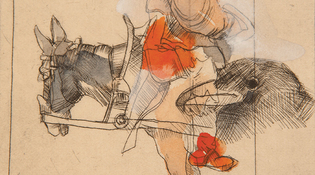 loading
loading
Arts & CultureJourneyObject lesson: an enigmatic piece of art from the Beinecke Library. Anya Montiel ’18PhD worked for eight years at the Smithsonian’s National Museum of the American Indian.  Beinecke Rare Book and Manuscript LibraryThis enigmatic print by Rick Bartow is part of a hand-bound book entitled Bosch; it was completed weeks before the artist’s death and donated to the Beinecke Library this past winter. View full imageThe scene portrayed in the print shown here, titled “Ride to Town,” by artist Rick Bartow, seems quotidian at first glance. But it becomes more of an enigma the longer the viewer gazes. Why isn’t the rider’s head visible? Why is the rider positioned backwards, with shoes reversed in the stirrups? Why is there a large raven’s head where the horse’s rump should be? The work is quite complex, but it may help to know that, in military funeral processions, a riderless horse with boots reversed in the stirrups is one of the highest honors and the mark of a fallen warrior. It symbolizes the rider looking back one last time. Bartow had watched the televised funeral procession of President John F. Kennedy, and the image of the ebony horse Black Jack following the casket, with empty boots in the stirrups, left an enduring impression on him. “Ride to Town” is part of a hand-bound book Bartow titled Bosch, of 13 drypoint prints painted in watercolor and gouache. His estate gave the book to the Beinecke in February 2017; he completed it two weeks before his death on April 2, 2016. Bosch joined two books of his drawings in the Beinecke and works at the Art Gallery and Institute of Sacred Music. Bartow was born in Newport, Oregon, in 1946 to a Native American (Wiyot) father and an Anglo mother. The Wiyot are indigenous to the Humboldt Bay region of northern California, but Bartow’s paternal ancestors had fled north after surviving massacres by local settlers following the Gold Rush. In 1969, Bartow received his bachelor’s in secondary art education from Western Oregon University. He served in the US Army during the Vietnam War, from 1969 to 1971. Assigned to a signal unit, Bartow spent his post-duty hours playing guitar at fire-support bases and at hospitals for the severely wounded. For his musical service, the Army awarded him a Bronze Star Medal. Suffering from the effects of post-traumatic stress disorder after his discharge, Bartow took several years to return to creating art, and many of his works dealt with themes of recuperation and survival. From the 1990s on, he was a prolific artist, working in drawing, print, and sculpture. Bartow often dedicated works to artists who inspired him; Bosch is named for the medieval artist Hieronymus Bosch. Bartow’s art, like Bosch’s, has been called dark and haunting. Asked about that description by interviewer Larry Abbott, Bartow replied, “What I’m looking for are images with emotion and power.” He never shied away from depicting potent experiences of love, anger, sorrow, or death. Bosch contains self-portraits and images of birds. Living along the Oregon coast, Bartow drew local fauna, especially birds. In “Ride to Town,” what the viewer takes at first for the horse’s rump is the head of a raven. It is a bird often regarded as a messenger, and in stories told by indigenous peoples of the north Pacific coast, Raven is both creator and trickster. “Ride to Town” exhibits Bartow’s fine draftsmanship and penchant for line making. He referred to his style as “gestural configuration”: he made multiple marks and then refined them into images. This print uses hachures (short parallel lines of shading) to refine the figures; color is used to highlight the clothes of the rider and the neck and leg of the horse. The backward-facing rider, the raven, and the truncation of the rider’s body may show us Bartow looking back on his life and anticipating death. He had become more aware of his mortality after his second stroke in 2013. Two years later, his doctor diagnosed congestive heart failure and estimated that he had one to two years to live. The 13th and last Bosch print, titled “Self Looking,” is a self-portrait depicting Bartow as frail bodied with shorn hair. He added concentric ovals emanating from his back—possibly a set of wings. “Ride to Town” is contemplative. The raven’s head looks west, toward the sunset.
|
|
1 comment
-

Richard Bockrath, 10:10am August 05 2017 |  Flag as inappropriate
Flag as inappropriate
The comment period has expired.Knowing nothing but what is illustrated, I wonder...? The position of the saddle over the forelegs of the beast and proportions of ears to head make me think it is a donkey not a horse. And what is shown of the saddle suggests it is turned back to front, with the rider as well. Consequently, the boots are not reversed in the stirrups at all. The rider and saddle are reversed atop a donkey. Does anyone else see it this way?